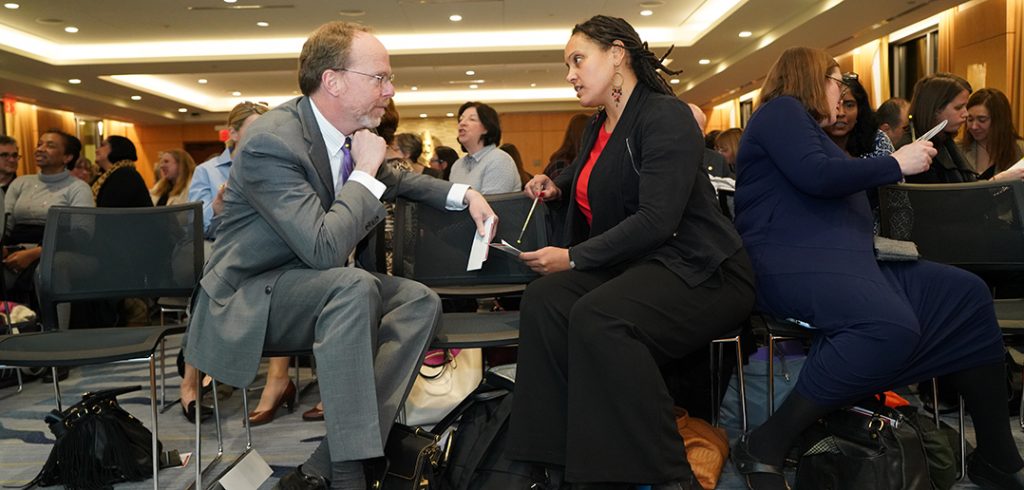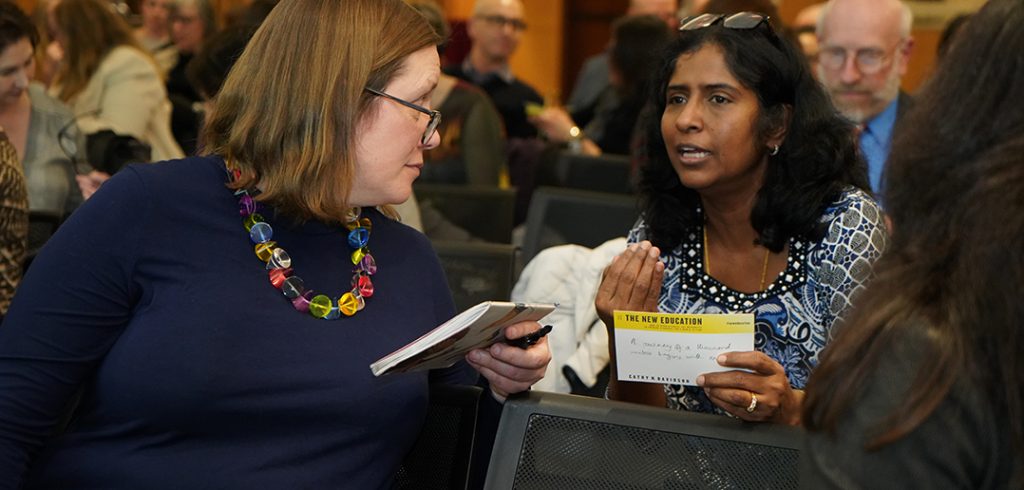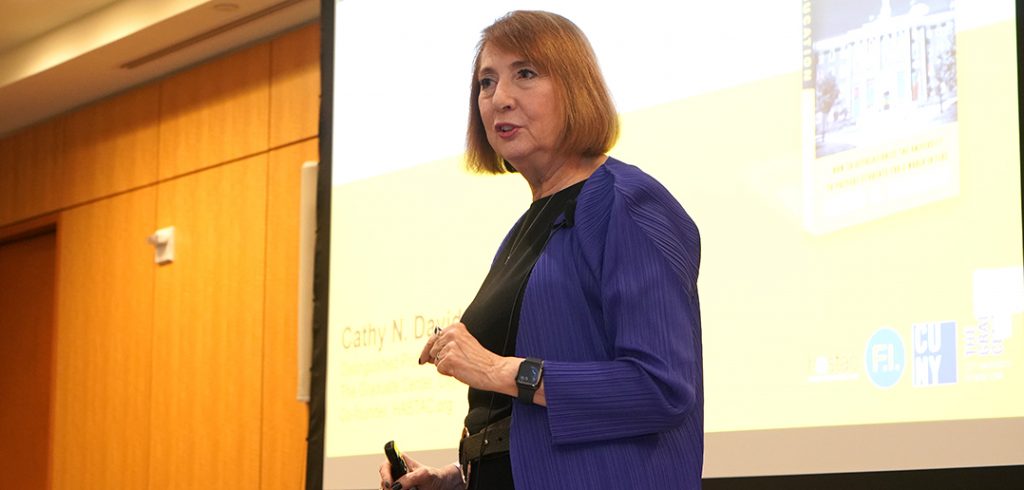The capacity audience included members of two groups from a new University initiative titled “ReIMAGINE Higher Ed”—an incubator group that will seek to reimagine the Ignatian University for the 21st Century, and a reading group that will examine case studies from Davidson’s book as well as other readings. The initiative is being spearheaded by Eva Badowska, Ph.D., dean of the faculty of arts and sciences, and Anne Fernald, Ph.D., professor of English and special advisor to the provost.
In introducing Davidson, Fordham Provost Dennis Jacobs, Ph.D., spoke frankly of an “increased mistrust” of universities at a time of “high polarization.”
“Fordham University does a lot of things well, but we’re not immune from these trends and concerns,” he said.
“I’m uplifted that Fordham is taking time to reflect on what the challenges are that lie ahead and is reimagining together how we prepare students for a world in flux.”

A Sinister Backstory to Standards
Davidson began by tracing the modern history of higher education, beginning with the origins of the letter grades A, B, C, D, and F. She said that it was the women’s college of Mount Holyoke that first instituted the letter grades, noting that F was added as the only referential grade, meaning “failure,” so that an E could not be misrepresented as “excellent.”
In time, she said, institutions of higher education reduced the complexities of learning to simple standardized measurements and expanded the practice to the ranking of students as well as institutions.
Without dismissing the value of university credentialing, she cast a light on the oftentimes sinister history of standards. She noted that former Harvard University President Charles Eliot, a champion of higher education standardization, who spent 40 years leading the education reform movement, was recently revealed to be a promoter of eugenics.
Eliot saw immigrants, and Catholics in particular, as a threat to the nation, she said. By World War I, a culture of I.Q. testing determined who would be sent to the front lines and who would become an officer, stationed away from the danger.
“These legacies are important. If we’re going to move forward, we have to know what our inheritance patterns are,” she said.
From there, a national credentialing system for everything from chemists to psychologists was born.
“We have a system of credentialing that’s methoding a system of credentialing, it’s one of the reasons it’s so hard to change because we’re constantly making self-referential systems,” she said, adding that it’s the same situation with school accreditation.
“Who created the first system of accreditation, the New England Association of Schools and Colleges? Charles Eliot. It’s hard to change because the standard by which you’re changing has standards for what is allowed and isn’t allowed for change.”

Digital Disruption
It’s within this legacy that the internet arose, promising users unfettered access to knowledge. She pegged the date to April 22, 1993, the day that the Mosaic 1.0 browser was introduced.
“Anyone with an internet connection can connect to anyone with an internet connection anonymously, without an editor or authorized publisher, or any kind of credential,” she said. “The utopian idea of the internet was that once you were anonymous and you didn’t need credentials, we’d all be making knowledge.”
The reality was that within six months of Mosaic’s introduction, a white supremacist group purchased the domain name of Martin Luther King Jr. to spread disinformation about the civil rights leader. The internet was quickly overwhelmed with fraud, bots, trolls, censorship, surveillance, massive corporate monopolies, and eventually, the devaluing and defunding of higher education, she said.
Within the tech sector, companies have in recent years created algorithms in their application process to screen out anyone without a STEM degree. Language, literature, history, and other liberal arts were considered “frills,” she said. But those same companies soon found themselves examining their own culture. Project Oxygen, which Google launched in 2013, found so-called “frills” majors yielded essential skills for advancement. Dubious of the findings, Davidson noted that the company turned to researchers from Stanford and Berkeley to study their findings. Their findings should cheer the hearts of liberal arts educators, she said.
“They hired a bunch of—hold your breath—cultural anthropologists to do ethnographic research, to go around Google and actually talk to people!” said.
“Sure enough, what they found in their data was certified by people that Google wouldn’t have even looked at before.”

A Way Forward
Davidson concluded her talk by pointing a way forward with four suggestions. First, she suggested restructuring the academic reward system so that that there is parity between research, teaching, and service. She said professors should be rewarded for researching how to advance the institution as they are rewarded for research within their own discipline. She also noted that service is leadership and should be referred to as “institutional leadership” and nothing less. Second, she said that the artificial wall between STEM and liberal arts should fall.
“It’s so demeaning to science not to have the humanities involved,” she said.
Third, she suggested rethinking the curriculum to stress life beyond school, navigating new technology, collaboration, and “critical thinking that leads to creative action.” Lastly, she encouraged a restructuring of class participation to become total participation. She said that novelist Samuel Delany insisted that all the students in his class raise their hands when he asked a question. She quoted him as saying:
“I’m going to call on you and if you don’t know the answer, I want you to say nice and clear: ‘I don’t know the answer to that, Professor Delany, but I would like to hear what that person has to say. And we’ll pass it on.’”
She said that while professors may appreciate the students who voluntarily raise their hand, they’re often the students who resemble the professor.
“That’s how you replicate the profession,” she said.
She added another upshot of everyone raising their hand.
“We actually know from cognitive neuroscience that’s a great way of saying, ‘I am here, I exist. I am in this room.’”

